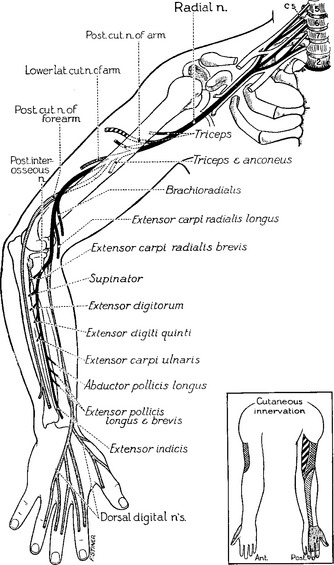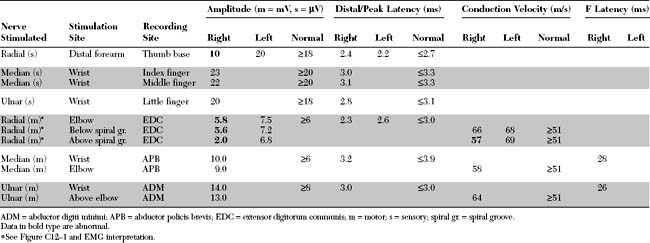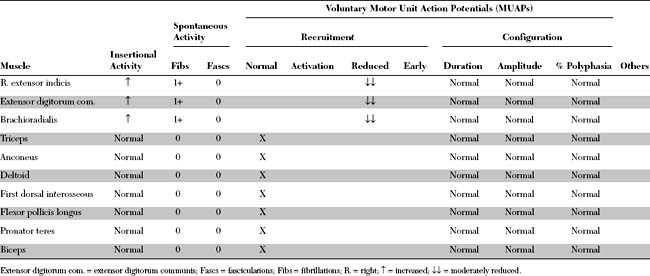Case 12
HISTORY AND PHYSICAL EXAMINATION
EMG examination was done 5 weeks postinjury.
Please now review the Nerve Conduction Studies (NCS) and Needle EMG tables.
QUESTIONS
EDX FINDINGS AND INTERPRETATION OF DATA
Abnormal EDX findings include:
1. A partial right radial motor conduction block across the spiral groove, as evidenced by a drop in amplitude of the compound muscle action potential (CMAP) from 5.6 mV, stimulating below the spiral groove, to 2.0 mV, stimulating above the spiral groove (Figure C12-1). This 64% amplitude decay is supported by the lack of significant CMAP dispersion and the concomitant decrease in negative CMAP area from 25.5 mV/ms to 5.65 mV/ms, respectively (78% area loss). Also, there is relative and mild focal slowing of the conducting radial motor fibers within the spiral groove (when the right radial motor nerve conduction velocity of 57 m/s is compared to the distal velocity of 66 m/s, and to the left radial motor velocities of 69 m/s proximally and 68 m/s distally). The presence of partial conduction block with relative mild focal slowing across the spiral groove is consistent with segmental demyelination at that site.
2. The distal radial CMAP is relatively low in amplitude on the right (5.8 mV) compared to the left (7.5 mV) and to the lower limit of normal value (6.0 mV). This is consistent with partial motor axonal loss distal to the site of the lesion (wallerian degeneration).
3. The right radial sensory nerve action potential (SNAP) is low in amplitude when compared with the left (10 μV versus 20 μV). This is consistent with partial sensory axonal loss distal to the site of the lesion (wallerian degeneration).
4. There is moderate impairment of recruitment with fibrillation potentials in all radial-innervated muscles except the triceps and anconeus. Abnormal muscles include the brachioradialis, which is innervated by the radial nerve proper, and the extensor indicis proprius and extensor digitorum communis, both of which are innervated by the posterior interosseous nerve. The recruited motor unit action potentials (MUAPs) are normal in configuration, a finding consistent with a recent injury prior to the establishment of sprouting.
DISCUSSION
Applied Anatomy
The radial nerve is the largest nerve in the upper extremity (Figure C12-2). It is a direct extension of the posterior cord of the brachial plexus, after takeoff of the axillary nerve, and contains fibers from all the contributing roots of the plexus (i.e., C5 through T1).

Figure C12-2 Anatomy of the radial nerve and its branches.
(From Haymaker W, Woodhall B. Peripheral nerve injuries: principles of diagnosis. Philadelphia, PA: WB Saunders, 1953, with permission.)
Buy Membership for Neurology Category to continue reading. Learn more here










